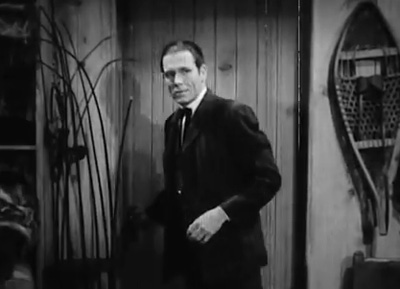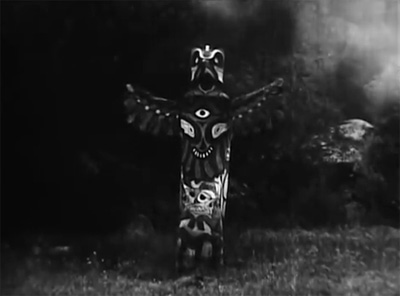
Columbia, 15 Chapters, 1942. Starring Robert Kellard, Kenneth MacDonald, Nell O’Day, George Chesebro, Herbert Rawlinson, Richard Fiske, Nick Thompson, John Elliott, Forrest Taylor, Art Miles, Rick Vallin, Jack Ingram, Al Ferguson, Charles King.
Villainous Mort Ransome (Kenneth MacDonald) hopes to preserve a monopoly on his lucrative fur trade with the Indians of Canada by obstructing the march of civilization. When railroad representative Winton (Herbert Rawlinson) arrives in the town of Sitawawkan with plans for laying track in the area, Ransome incites the Indians to attack the train crews in an attempt to keep out the railroad and the settlers it will bring. RCMP Sergeant MacLane (Robert Kellard) is assigned to protect the railroad, bring in Ransome’s gang of outlaws, and pacify the Indians–although it takes him quite a while to learn that the supposedly respectable Ransome is back of all the trouble.
Perils of the Royal Mounted is one of the most frustrating and least enjoyable of director James W. Horne’s serials; it lacks the persistently comic tone that made The Green Archer, Captain Midnight, and–especially–The Iron Claw entertaining if disjointed, but still contains enough of Horne’s typical comedic touches to undermine the ostensibly serious plotline and sabotage the many potentially exciting pieces of action that dot the serial.
Perils’ plot is a repetitive one, alternating between Ransome’s attempts to stir up the Indians against the settlers or to rouse the settlers against the Indians, with a few gun-running and kidnapping schemes thrown in to vary the formula. Still, such storylines proved perfectly serviceable in many Western serials, and Perils could easily have been a solid effort if played straight. What sinks it is the outrageous overacting of several of the leading players and the cartoonish handling of the action scenes–which can’t be blamed on writers Scott Littleton, Louis Heifetz, Jesse Duffy, and Basil Dickey, being as they are the unmistakable handiwork of James Horne.
The serial’s fight scenes, as in most Horne chapterplays, are executed in comic rather than thrilling fashion; they consist of wild and over-crowded brawls in which the hero improbably combats four or five heavies at once, with the participants shoving each other and swinging their arms in decidedly slapstick fashion. The cliffside fight in Chapter Three is a prime example, as are the fight at the fur company offices in Chapter Six and the Chapter Eight mine fight; the Chapter One saloon brawl, with fewer heavies involved, is a bit better-handled, but it’s also subtly undermined by a running gag in which the bartender keeps dodging thrown chairs.


Above: A squad of henchmen comically retreat before a chair-swinging old man (John Elliott), then get slugged around the trading post by one outnumbered Mountie (Robert Kellard) in a characteristic Perils action sequence.
Non-fistfight action scenes are less silly, and include some genuinely exciting foot and horseback chases–some of them filmed at Iverson’s Ranch, and some of them shot in the impressive forests of the San Bernardino State Forest area. The pursuit of the stagecoach in Chapter Five is particularly good, while the first-chapter attack on the supply wagons in Chapter One and the foot chase in the forest in Chapter Three also make excellent use of the scenery. The villains’ hideout beneath a phony waterfall controlled by a gate and a big windlass gives the serial some additional visual interest.

Above: Robert Kellard rides to the rescue through the pines of the San Bernardino state forest.
The staging of the cliffhanger sequences shows perhaps the strongest Horne influence; most of them are perfectly acceptable in concept, but are resolved with physically impossible solutions that destroy all suspension of disbelief. Examples include a mine cart falling on the unconscious hero, the hero and heroine sailing off a cliff in a wagon, and the hero being squashed by an exploded safe door. All of these are standard serial perils–but, instead of rolling out of the way of the mine car, our hero simply lets it land on top of him and then crawls out from beneath it, none the worse for wear; instead of jumping from the wagon or falling into a lake, the hero and heroine survive the wagon’s crushing fall onto a rocky slope. The safe-door cliffhanger is resolved in even more ridiculous style; the explosion not only blows the door down on top of the hero, but brings down the roof of the surrounding room as well, blocking the heavies’ attempts to re-enter the scene. The hero then crawls out from under the rubble and cheerily explains that the villains used too much explosive, which prevented them from coming back to finish him off–ignoring the fact that had the charge indeed been so heavy, the force of the blown-off safe door would have flattened him to a pancake. As testified by several of his actors, Horne would frequently insert bits of business into his serial’s scripts, and such outrageous cliffhanger resolutions were undoubtedly his idea–probably intended as over-the-top parodies of the frequently improbable “lived-through-it” resolutions common in contemporary Universal serials.

Above: How the heck are our hero and heroine going to survive this one? Easy, they’re made out of rubber.
Most of the acting in Perils shows the Horne influence as well; leading man Robert Kellard (billed as Robert Stevens), who delivered good performances in Republic’s Drums of Fu Manchu and King of the Royal Mounted, overacts to a very annoying degree here–shouting most of his lines at the top of his lungs and interrogating villains in an aggressive, confrontational fashion that makes him seem more bully than hero. Expert horsewoman Nell O’Day, a charming heroine in many B-westerns, is also rather off-putting here, generally acting either pouty or obnoxiously sarcastic in her exchanges of alleged “banter” with the hero

Above: Nell O’Day watches as Robert Kellard prepares to get excessively aggressive with an off-camera suspect.
George Chesebro, Jack Ingram, Bud Osborne, Al Ferguson, Stanley Price, I. Stanford Jolley, Harry Tenbrook, and Charles King make up the serial’s henchman pack, but function more as a Keystone-Kop-style comedy team than actual menaces–bickering among each other constantly, stumbling around awkwardly in the action scenes, playing silly pranks on each other, laughing cartoonishly over temporarily successes, and acting nervous instead of assuredly villainous when combating the Mounties. This characteristic Horne depiction of the heavies not only deprives the serial of all suspense, but also serves to make the “heavies” a lot more lovable than the bad-tempered “hero.”

Above: Clownish heavies Charles King and Al Ferguson exchange comically puzzled glances.
Kenneth MacDonald is the only villain who plays things straight, making his Ransome seem slick, cunning, and authoritative despite the eccentricity of his followers. However, MacDonald’s smooth performance, effectively sinister as it is, is one of the main factors that prevents the serial from being as entirely comic as Green Archer or Captain Midnight, in which James Craven portrayed brains heavies who were even more laughable in demeanor than their henchmen.

Above: Kenneth MacDonald, typically cool and collected.
John Elliott, as the heroine’s trading-post-owner father only overacts occasionally (as when complaining of the stifling atmosphere of the villains’ hideout); in most of his scenes, he’s laid-back to the point of somnambulism. The usually dignified and quiet-spoken Herbert Rawlinson is blustering and thoroughly unpleasant as railroad-builder Winton, while Forrest Taylor is hammily hilarious as the villains’ spy in town, the phony preacher Hinsdale–alternately delivering pious lectures with hypocritical unctuousness and flying into hysterical fits of panic.

Above: Forrest Taylor asks Robert Kellard for permission to talk to the “miserable sinners” that Kellard has just arrested. Richard Fiske is standing by the door.
Richard Fiske is uncharacteristically subdued but very likable as hero Kellard’s Mountie aide, coming off as far more appealing than Kellard himself. Kermit Maynard also delivers a solid, non-exaggerated supporting performance as another key Mountie. Rick Vallin too eschews tongue-in-cheek touches as friendly Indian Little Wolf, while Art Miles plays things much more broadly as Vallin’s father Chief Flying Cloud, coming off as both comically self-important and excessively gullible. Nick Thompson is even more comical as the sneaky but lazy medicine man Black Bear, who continually displays much more interest in the contents of Ransome’s whiskey jug than he does in Ransome’s schemes; he even drops off to sleep during one villainous plotting session.
Hank Bell and Tom London play a pair of local trappers who fluctuate wildly between belligerently opposing the Mounties and cheerfully assisting them; such schizophrenic supporting characters are a hallmark of many Western serials, but Horne here emphasizes them to a self-parodying degree–taking much the same tack with the sometimes-hostile/sometimes-peaceful Indians. Kenneth Harlan pops up as a bogus district commissioner imported by the villains, Edward Cassidy as another agent of the heavies, Harry Harvey as a weasely telegrapher, and C. Montague Shaw–who manages to preserve most of his usual dignity–as the genuine commissioner.
There’s not much more to be said about Perils of the Royal Mounted; there’s a reason why it’s the least-known and the most infrequently discussed of Horne’s Columbia serials. Not containing enough comedy to make it memorably bizarre, but still featuring enough Horne hallmarks to make it disappointing to serious serial buffs, it has a few good moments but comes off overall as a decidedly tedious chapterplay.

Good review .Just the fact that Horne directed is enough to turn me away.
Another one that’s been a long time on the back burner. No need for much in the way of comments, as your excellent review covers everything that I might have said. Actually, my only real interest was in seeing Robert Kellard’s performance, and I certainly came away disappointed. Sometimes an actor benefits from the director’s influence; in this case, the opposite seems to have been true. He was a unbearably strident at times. Horne seems to have had the same effect on Rawlinson as well. The qualities that made their work appealing in “King of the Royal Mounted” are totally missing here.